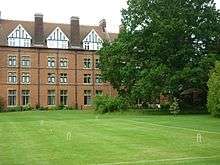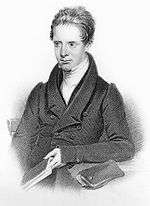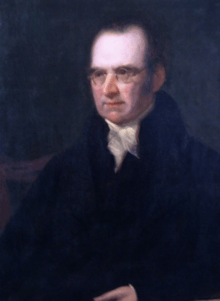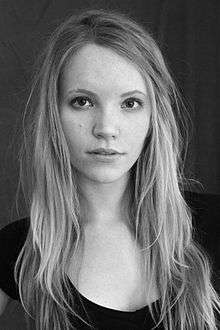Homerton College, Cambridge
| Homerton College | ||||||||||||
|---|---|---|---|---|---|---|---|---|---|---|---|---|
|
The Cavendish Building, Homerton College | ||||||||||||
 | ||||||||||||
|
| ||||||||||||
| University | Cambridge University | |||||||||||
| Location | Hills Road (map) | |||||||||||
| Motto | Respice Finem (Latin) | |||||||||||
| Motto in English | Look to the end | |||||||||||
| Established | 1768 | |||||||||||
| Named for | Homerton, London | |||||||||||
| Previous names |
Homerton Academy (1768-1852) Training Institution of the Congregational Board of Education (1852-1894) | |||||||||||
| Sister college |
Harris Manchester College, Oxford Mansfield College, Oxford | |||||||||||
| Principal | Geoff Ward | |||||||||||
| Undergraduates | 600 | |||||||||||
| Postgraduates | 800 | |||||||||||
| Website |
www | |||||||||||
| JCR |
www | |||||||||||
| MCR |
www | |||||||||||
| Boat club |
www | |||||||||||
Homerton College is a constituent college of the University of Cambridge in England. Its first premises were acquired in London in 1768, by an informal gathering of Protestant dissenters with origins in the seventeenth century. In 1894 the College moved from Homerton High Street, Hackney, London, to Cambridge, and received its Royal Charter in 2010, affirming its status as a full college of the university. The College will be celebrating its 250th anniversary in 2018.[1]
With around 600 undergraduates, 800 graduates, and 90 fellows, it has more students than any other Cambridge college, but because only half of these are resident undergraduates its undergraduate presence is similar to large colleges such as Trinity and St John's. Homerton has educated alumni of considerable influence – including prominent dissenting thinkers, educationalists, politicians, and missionary explorers. In this sense, the College has particularly strong ties to public service as well as academia.[2]
Homerton was admitted as an "Approved Society" of the university in 1976, and was granted full college status by the university in 2010. The College has extensive grounds which encompass sports fields, water features, beehives and the focal point of the college, its Victorian Gothic hall. It also has a wide range of student clubs and societies, including Homerton College Boat Club, Homerton College Music Society and the Homerton College Rugby Football Club. In 2011 and 2012 the college was also selected to field a team on University Challenge.
_2012.jpg)
History
Early history
In 1850 Homerton Academy in London, a dissenting academy already having a history stretching back to 1695, was refounded by the Congregational Board of Education to concentrate on the study of education itself. It did so by transferring its theological courses to New College London, whose Congregationalist Principal was the Rev. John Harris DD, and by extending and rebuilding the old mansion house and 1820s buildings of the academy at a cost of £10,000. The college reopened as the Training Institution of the Congregational Board of Education in April 1852, with Samuel Morley as its Treasurer. Shortly afterwards, it began admitting women students, although then Principal Horobin ultimately called an end to mixed education in 1896, shortly after the move to Cambridge, and thereafter the college remained all-women for 80 years.[3]
Towards the end of the century, the growth of industry had turned the village of Homerton into a manufacturing centre, lowering the quality of life of the students and leading to seven deaths between 1878 and 1885 from tuberculosis, smallpox and typhoid. Also, increasing numbers of students required more space.
In 1881 former students of Homerton College who were members of Glyn Cricket Club formed a football section to help keep their players fit during the winter months. The football section continued to grow over the ensuing years and is now Leyton Orient Football Club - a fact acknowledged by an annual match between the college's football team and that of the Leyton Orient Supporters Club.[4]
Move to Cambridge
In 1894 the Congregational Board of Education were able to purchase the estate of Cavendish College, Cambridge (named after the then-Chancellor of the university and not to be confused with Lucy Cavendish College) which had become available. It had been founded to allow poorer students to sit Cambridge tripos exams without the expense of joining a true Cambridge college, and was briefly recognised as a "Public Hostel" of the university in 1882, but a lack of money had brought the venture to an end.
All its estates and furniture were bought by the Congregational Board for £10,000; and their students and staff moved from the old Hackney premises into the vacant college buildings at Cambridge. Initially taking the name of Homerton New College at Cavendish College, it shortly became just Homerton College, Cambridge. John Charles Horobin became the first Principal, and his portrait still hangs in the college's Great Hall.[5]
The first woman to head the college was Mary Miller Allan, who was responsible for Homerton's national reputation as a trainer of women teachers.[6] Her successor in 1935 was Miss Alice Skillicorn, a former HMI, who took the college through World War Two, during which time it was bombed.[7] Dame Beryl Paston Brown was Principal in the 1960s — at a time when Homerton’s numbers doubled after the introduction of three-year training courses in 1960.[8]
Closer association with the university
In December 1976, under the headship of Principal Alison Cheveley Shrubsole,[9] Homerton was accepted as an Approved Society of the University of Cambridge following a 3-1 vote of the Regent House in favour of its admittance. The possibility of introducing a Cambridge Bachelor of Education (B.Ed.) degree was even given as one of the reasons for the original move into Cambridge. It was after the shake-up and governmental criticisms of teacher training in the early 1970s that the university admitted Homerton, as now all of its students were doing four-year honours courses.

In late 2000 the Regent House approved a proposal to "converge" Homerton with the rest of the university.[10] Convergence involved the transfer of most of the college's teaching and research activity to the new University of Cambridge Faculty of Education and the diversification of the college into a wide range of Tripos subjects. In September 2001 Homerton admitted its first non-education Tripos students. At the same time the old B.Ed. degree was retired in favour of a three-year B.A. in Education, followed by a one-year Post Graduate Certificate of Education.
At the time of convergence it was envisaged that Homerton would move from the status of Approved Society to that of Approved Foundation or full college. In December 2008 Homerton's application to move to full college status was approved by the University Council.[11] The change in status was completed with the grant of a Royal Charter on 11 March 2010.
Buildings and grounds


The original Victorian Cavendish College buildings were constructed in 1876 in the Gothic Revival style, using a combination of red Suffolk brick and Bath stone dressings. One of the most notable features is an oak doorway with an ogee arch flanked above by ornamental grotesques.[4] Several years later, the Cambridge architect William Wren designed additions to the eastern end of the college buildings in the Neo-Gothic style - now occupied by the Principal's office.[4] The castellated tower is the tallest part of the original college buildings, and it is possible to see the spires of Ely Cathedral on a clear day from its uppermost floor.[12]
The Great Hall is one of the largest and grandest dining halls in Cambridge. When it was built in 1889 it was the largest college hall in Cambridge.[13] It now houses one of the college's most notable works of art - the celebrated Pre-Raphaelite piece by Jane Benham Hay known as 'The Florentine Procession', painted in the 1860s and winning 'Picture of the Year' in the 1867 Saturday Review.[14] Also encircling the Hall are portraits of former Principals of the college.[15] The Hall itself features a hammer-beam roof, American walnut panelling, a gallery, rose windows, a fleche,[4] and a bell originating from the old college in London which sounds before the College Grace is read at Formal dinner.
Other notable buildings of the college include the Ibberson Building built in 1914 (named after its architect, Herbert George Ibberson) which is considered by many - including Nikolaus Pevsner in his Buildings of England - to be the college's most significant building; a fact mirrored by its Grade Two listed status, the only listed building on the site. An example of arts and crafts style architecture, its present-day Combination Room was probably the only grade two listed gymnasium in the world.[16] Also of interest is Trumpington House (completed in 1847, and which once held the college's wine collection in its basement) built in the style of classical revival and currently leased to the Faculty of Education.[12]
Unlike the majority of Cambridge colleges, Homerton offers on-site accommodation for its students for all three years. This is provided by four purpose-built accommodation buildings: East House, West House, South Court (the latest addition to the college, opened in 2007), and Harrison House. Harrison House exclusively houses graduate students and fellows, and was opened in November 2006. Other accommodation is provided in the ABC and D&E blocks, both part of the main college buildings, as well as in Queen's Wing (opened by Queen Elizabeth the Queen Mother in 1957[17]) which also contains the Homerton Union of Students and both the Undergraduate and Graduate Common Rooms. Outside of university terms, the accommodation attracts extensive use for conference purposes.[18]

Like the other colleges of the University, Homerton's library includes thousands of books covering numerous academic disciplines. Unique to Homerton, however, is a children's book collection, which contains early editions of many famous books from 1780 onwards.[19]
Homerton has more green space around its buildings than many other Cambridge colleges. In its grounds are several rare examples of wild orchids and over 150 species of plants, which act as a rich habitat for various forms of wildlife - including grey squirrels, carrion crows, woodpeckers, stock doves, rabbits, the 'College fox', and in the summer a small colony of swifts, which nest under the eaves of the roof of the Cavendish building after their return from Africa.[20] There is also a large orchard, where students relax in warm weather.
Traditions
Homerton has several unique traditions. Perhaps the most significant is that displayed at its Matriculation Dinner, where new undergraduates are made to form two lines and drink wine from the 'Homerton Horn' - an African cow horn with silver mounts, whilst speaking several Anglo-Saxon phrases to one another (including the greeting "Wassail!", and the response "Frith and Freondship sae th'y'" - 'peace and friendship be with you').[21]
Because the college was all-female for much of its history, the design of the college gown is that of those traditionally worn by female undergraduates in early twentieth century Cambridge (this is shared by all the historically-female colleges: Girton, Newnham, and Murray Edwards). The gown is based on the original Cambridge black gown, still worn by undergraduates at Peterhouse, but has the slits in the sleeves closed up. As a homage to its all-female origins, or simply because the college has never had one re-designed, this gown is now worn by all undergraduates at the college regardless of sex.[22]
Homerton College Boat Club
Homerton College Boat Club (HCBC) is the rowing club for members of Homerton College. HCBC colours are navy blue with white trim, although the club's Zephyr (garment) is white with blue trim. It is traditional to wear a sock of each of the boat club's colours when racing with a blue sock on the foot opposite the rigger.
HCBC Oxbridge Record
The Men's 1st VIII also hold the Oxbridge record for the most places advanced during one series of bumps (either Mays, Lents, or Torpids/Eights for Oxford), advancing 14 places in the May Bumps 2001, where the crew moved up a division to division 3 and also won blades.[23]
People associated with Homerton
Principals, treasurers, fellows (including honorary fellows) or students who studied at Homerton Academy or Homerton College before and after it officially became part of Cambridge University. Graduates of the college are collectively known as Homertonians.
 Samuel Dyer (1804–1843), typographer and translator of the Bible into Chinese.
Samuel Dyer (1804–1843), typographer and translator of the Bible into Chinese. William Ellis (1794–1872) English missionary, traveller, geographer, and ethnographer.
William Ellis (1794–1872) English missionary, traveller, geographer, and ethnographer. Robert Cotton Mather (1808–1877), English missionary, author, and translator in India.
Robert Cotton Mather (1808–1877), English missionary, author, and translator in India.- Edward Stallybrass (1794-1884), translator of the Bible into Mongolian.
 William Johnson Fox (1786–1864) English religious and political orator.
William Johnson Fox (1786–1864) English religious and political orator. Charles Wellbeloved (1769–1858) English Unitarian divine, archaeologist, and author.
Charles Wellbeloved (1769–1858) English Unitarian divine, archaeologist, and author. Tamzin Merchant (born 1987), English actress.
Tamzin Merchant (born 1987), English actress. Olivia Colman (born 1974), BAFTA award-winning English actress.
Olivia Colman (born 1974), BAFTA award-winning English actress. Sir Peter Maxwell Davies, CH, CBE (1934–2016) Honorary Fellow. English composer and conductor; Master of the Queen's Music.
Sir Peter Maxwell Davies, CH, CBE (1934–2016) Honorary Fellow. English composer and conductor; Master of the Queen's Music. Sir Andrew Motion, FRSL (born 1952) Honorary Fellow. English poet, novelist, and biographer; Poet Laureate from 1999 to May 2009.
Sir Andrew Motion, FRSL (born 1952) Honorary Fellow. English poet, novelist, and biographer; Poet Laureate from 1999 to May 2009..jpg) Dame Carol Ann Duffy, DBE, FRSL (born 1955) Honorary Fellow. British poet and playwright; Poet Laureate since May 2009.
Dame Carol Ann Duffy, DBE, FRSL (born 1955) Honorary Fellow. British poet and playwright; Poet Laureate since May 2009.
| Name | Birth | Death | Career |
|---|---|---|---|
| John Conder | 1714 | 1781 | Independent minister and tutor. |
| Daniel Fisher | 1731 | 1807 | Dissenting minister and tutor. |
| Henry Mayo | 1733 | 1793 | Independent minister and editor of The London Magazine. Samuel Johnson's adversary and "literary anvil" according to his biographer James Boswell.[24] |
| John Fell | 1735 | 1797 | Congregationalist minister and classical tutor. |
| Samuel Blatchford | 1767 | 1828 | First President of the Rensselaer Polytechnic Institute, the oldest technological university in the English-speaking world. |
| John Pye-Smith | 1774 | 1851 | Congregational theologian, author, and tutor, associated with reconciling geological sciences with the Bible, repealing the Corn Laws and abolishing slavery. |
| Ezekiel Blomfield | 1778 | 1818 | Congregational minister, influential author and compiler of religious works and works on natural history. |
| William Johnson Fox | 1786 | 1864 | English religious and political orator. |
| William Ellis | 1794 | 1872 | English missionary, traveller, geographer, and ethnographer. |
| Edward Stallybrass | 1794 | 1884 | British missionary to the Buryat people of Siberia; translator of the Bible into Mongolian. |
| Robert Halley | 1796 | 1876 | English Congregationalist minister and abolitionist. He was noted for his association with the politics of Repeal of the Corn Laws, and became Classical Tutor at Highbury College and Principal of New College London. |
| William Jacobson | 1803 | 1884 | Regius Professor of Divinity at Oxford University (1848–1865), Vice-Principal of Magdalen Hall (later Hertford College, Oxford) (1832) and Bishop of Chester (1865–1884). |
| Samuel Dyer | 1804 | 1843 | British Protestant missionary to China, pioneering typographer and translator of the Bible into Chinese. |
| Robert Cotton Mather | 1808 | 1877 | English missionary, author, and translator in India. |
| Samuel Morley | 1809 | 1886 | English manufacturer, philanthropist, dissenter, abolitionist, political radical, and statesman. |
| Leah Manning | 1886 | 1977 | British educationalist, social reformer, and Labour Member of Parliament (MP). Organised the evacuation of Basque children during the Spanish Civil War. |
| Betty Rea | 1905 | 1965 | English sculptor and educationalist. |
| Efua Sutherland | 1924 | 1996 | Ghanaian playwright, children's author, and dramatist. Founder of the Ghana Drama Studio, the Ghana Society of Writers, and the Ghana Experimental Theatre. |
| Dora Jessie Saint | 1913 | 2012 | Best known by her pen name Miss Read; English novelist and schoolmistress. |
| John Hopkins | 1949 | British composer. | |
| Tony Little | 1954 | British schoolmaster, former head of Chigwell School and Oakham School before becoming headmaster of Eton College in 2002. | |
| Julie Covington | 1946 | English singer and actress, best known for recording the original version of "Don't Cry for Me, Argentina". | |
| Cherie Lunghi | 1952 | English film, television, and theatre actress. | |
| Nick Hancock | 1962 | English actor and television presenter; former presenter of Room 101. | |
| Jan Ravens | 1958 | English actress and impressionist, first female President of the Cambridge University Footlights. | |
| Olivia Colman | 1974 | BAFTA award-winning English actress. | |
| Tamzin Merchant | 1987 | English actress; best known for her roles in the 2005 film Pride & Prejudice and in the television series The Tudors. |
Principals
A list of Homerton principals since the college relocated to Cambridge in 1894.
| Principal | Tenure |
|---|---|
| John Charles Horobin | 1894–1902 |
| Mary Miller Allan | 1903–1935 |
| Alice Havergal Skillicorn | 1935–1960 |
| Dame Beryl Paston Brown | 1961–1971 |
| Alison Cheveley Shrubsole | 1971–1985 |
| Alan George Bamford | 1985–1991 |
| Kate Pretty | 1991–2013 |
| Geoff Ward | 2013–Present |
References
- ↑ (Raby & Warner 2010, p. 9)
- ↑ See 'People associated with Homerton' in this article
- ↑ Edwards, Elizabeth (14 January 2004). Women in Teacher Training Colleges, 1900-1960: A Culture of Femininity. Routledge. p. 76. ISBN 0-415-21475-0.
- 1 2 3 4 Raby, P.; Warner, P. (2010). Homerton: The Evolution of a Cambridge College. Fellows of Homerton College. p. 184.
- ↑ "BBC - Your Paintings - John Charles Horobin (1856–1902), Principal of Homerton College (1894–1902)". BBC.co.uk. Retrieved 14 September 2014.
- ↑ (Edwards 2004, p. 77)
- ↑ (Edwards 2004, pp. 84–87)
- ↑ (Edwards 2004, p. 164)
- ↑ "Alison Cheveley Shrubsole". The Tinmes. Retrieved 14 September 2014.
- ↑ "Reporter 22/11/00: Joint Report of the Council and the General Board on Teaching and Research in Education, and on Homerton College". University of Cambridge. Retrieved 14 September 2014.
- ↑ "Reporter 17/12/08:". University of Cambridge. Retrieved 14 September 2014.
- 1 2 (Raby & Warner 2010, p. 110)
- ↑ "The Great Hall". Homerton Conference. Archived from the original on 16 December 2009. Retrieved 14 September 2014.
- ↑ (Raby & Warner 2010, p. 121)
- ↑ (Raby & Warner 2010, p. 123)
- ↑ (Raby & Warner 2010, p. 111)
- ↑ (Raby & Warner 2010, p. 112)
- ↑ "Homerton Conference Centre". Homerton Conference. Retrieved 14 September 2014.
- ↑ (Raby & Warner 2010, p. 145)
- ↑ (Raby & Warner 2010, pp. 97–106)
- ↑ (Raby & Warner 2010, pp. 242–3)
- ↑ . The Cambridge University Heraldic & Genealogical Society https://web.archive.org/web/20120603231230/http://www.societies.cam.ac.uk/cuhags/gowns/ho.htm. Archived from the original on June 3, 2012. Retrieved 14 September 2014. Missing or empty
|title=(help) - ↑ Raby, P. & Warner, P. (2010). Homerton: The Evolution of a Cambridge College (Published and Distributed by the Principal and Fellows of Homerton College), p.198
- ↑ "Henry Mayo". Oxford Dictionary of National Biography.
Further reading
- Edwards, Elizabeth (14 January 2004). Women in Teacher Training Colleges, 1900-1960: A Culture of Femininity. Routledge. ISBN 0-415-21475-0.
- Simms, T.H. (1979). Homerton College 1695–1978 Published by the Trustees of Homerton College
- Warner, Dr Peter. Lecture on the history of Homerton College (Michaelmas term 2004)
- Raby, P. & Warner, P. (2010). Homerton: The Evolution of a Cambridge College (Published and Distributed by the Principal and Fellows of Homerton College)
External links
| Wikimedia Commons has media related to Homerton College, Cambridge. |
- Homerton College website
- Homerton College JCR website
- Homerton College MCR website (Graduate Society)
Coordinates: 52°11′11″N 0°08′12″E / 52.1864°N 0.1366°E

